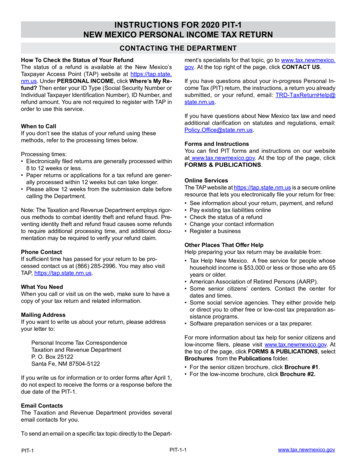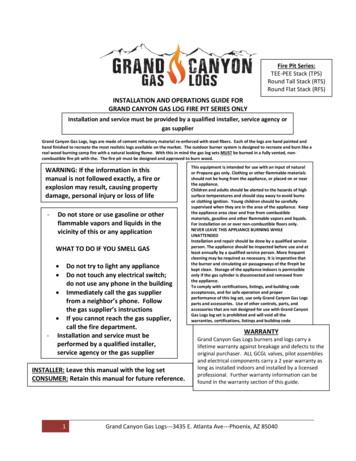
Transcription
INSTRUCTIONS FOR 2020 PIT-1NEW MEXICO PERSONAL INCOME TAX RETURNCONTACTING THE DEPARTMENTHow To Check the Status of Your RefundThe status of a refund is available at the New Mexico’sTaxpayer Access Point (TAP) website at https://tap.state.nm.us. Under PERSONAL INCOME, click Where’s My Refund? Then enter your ID Type (Social Security Number orIndividual Taxpayer Identification Number), ID Number, andrefund amount. You are not required to register with TAP inorder to use this service.When to CallIf you don’t see the status of your refund using thesemethods, refer to the processing times below.Processing times: Electronically filed returns are generally processed within8 to 12 weeks or less. Paper returns or applications for a tax refund are generally processed within 12 weeks but can take longer. Please allow 12 weeks from the submission date beforecalling the Department.Note: The Taxation and Revenue Department employs rigorous methods to combat identity theft and refund fraud. Preventing identity theft and refund fraud causes some refundsto require additional processing time, and additional documentation may be required to verify your refund claim.Phone ContactIf sufficient time has passed for your return to be processed contact us at (866) 285-2996. You may also visitTAP, https://tap.state.nm.us.What You NeedWhen you call or visit us on the web, make sure to have acopy of your tax return and related information.Mailing AddressIf you want to write us about your return, please addressyour letter to:Personal Income Tax CorrespondenceTaxation and Revenue DepartmentP. O. Box 25122Santa Fe, NM 87504-5122If you write us for information or to order forms after April 1,do not expect to receive the forms or a response before thedue date of the PIT-1.ment’s specialists for that topic, go to www.tax.newmexico.gov. At the top right of the page, click CONTACT US.If you have questions about your in-progress Personal Income Tax (PIT) return, the instructions, a return you alreadysubmitted, or your refund, email: TRD-TaxReturnHelp@state.nm.us.If you have questions about New Mexico tax law and needadditional clarification on statutes and regulations, email:Policy.Office@state.nm.us.Forms and InstructionsYou can find PIT forms and instructions on our websiteat www.tax.newmexico.gov. At the top of the page, clickFORMS & PUBLICATIONS.Online ServicesThe TAP website at https://tap.state.nm.us is a secure onlineresource that lets you electronically file your return for free: See information about your return, payment, and refund Pay existing tax liabilities online Check the status of a refund Change your contact information Register a businessOther Places That Offer HelpHelp preparing your tax return may be available from: Tax Help New Mexico. A free service for people whosehousehold income is 53,000 or less or those who are 65years or older. American Association of Retired Persons (AARP). Some senior citizens’ centers. Contact the center fordates and times. Some social service agencies. They either provide helpor direct you to other free or low-cost tax preparation assistance programs. Software preparation services or a tax preparer.For more information about tax help for senior citizens andlow-income filers, please visit www.tax.newmexico.gov. Atthe top of the page, click FORMS & PUBLICATIONS, selectBrochures from the Publications folder. For the senior citizen brochure, click Brochure #1. For the low-income brochure, click Brochure #2.Email ContactsThe Taxation and Revenue Department provides severalemail contacts for you.To send an email on a specific tax topic directly to the DepartPIT-1PIT-1-1www.tax.newmexico.gov
INSTRUCTIONS FOR 2020 PIT-1GENERAL INSTRUCTIONWHO MUST FILEWho Must File A PIT-1 ReturnNew Mexico’s law says every person who meets both thefollowing conditions must file a PIT-1: Every person who is a New Mexico resident or hasincome from New Mexico sources. Every person who is required to file a federal income taxreturn.This section covers the following: New Mexico Residents; Non-Residents; Military Servicemembers; General Information About Military Servicemembers’Spouses; Non-resident Military Spouse Who Lives in New Mexico; Resident Military Spouse Who Lives in Another State;and Members of Indian Nations, Tribes, or Pueblos.New Mexico ResidentsIf you are a New Mexico resident, you must file a New Mexicoreturn if you meet any of the following conditions: You are required to file a federal return. You want to claim a refund of any New Mexico stateincome tax withheld from your pay. You want to claim any New Mexico rebates or credits.Non-ResidentsIf you are a non-resident, including a foreign national or aperson who resides in a state without income taxes, youmust file in New Mexico when both the following are true: You are required to file a federal return. You have income from any New Mexico source whatsoever.Military ServicemembersIf you are a member of the United States Armed Forces,your income may be taxable to New Mexico and you mustfile a resident return if both the following are true: You were domiciled in New Mexico at the time of enlistment. You have not changed your domicile for purposes ofwithholding state income tax from military pay.NOTE: Military servicemembers may claim a deduction formilitary active duty pay included in federal adjusted grossincome.If your permanent home (domicile) was in New Mexico whenyou entered the military, and you kept New Mexico as yourdomicile for state withholding tax purposes, even if you arepresently serving outside New Mexico, you must file a NewMexico resident return.PIT-1If your permanent home (domicile) was in New Mexico whenyou entered the military, but you have established domicilein another state and changed your legal residence for withholding state income tax, your military pay is not subject toNew Mexico income tax.If you are an enrolled member of an Indian nation, tribe,or pueblo, your military pay is exempt when your home ofrecord is on the lands of that Indian nation, tribe, or puebloand the legal residence for state withholding tax purposeshas not been changed.If you are a non-resident, a United States Public HealthService (USPHS) servicemember, and you earned incomein New Mexico for USPHS active duty, your pay is exemptfrom New Mexico taxes.General Information About Military Servicemembers’SpousesBeginning with tax year 2018, the Veterans Benefits andTransition Act allows a military servicemember’s spousewho moves to a state solely to be with their spouse who isthere because of military orders, to keep their out-of-stateresidency status and domicile.They may source their non-military wages, salaries, tips andother income from services performed to their chosen stateof domicile instead of the state where the income is earned.For tax purposes, this can be either the domicile state thatthe servicemember claims or the state in which the servicemember’s spouse has established domicile.The following restrictions apply to servicemembers and theirspouses: Servicemembers must have declared domicile in theother state. Servicemembers must be in the state in compliance withmilitary orders. Servicemembers’ spouses must be in the state solely tobe with their spouses.NOTE: Non-resident servicemembers must continue to allocate non-military income from services performed to thestate where the income was earned.Non-Resident Military Spouse Who Lives in New MexicoIf you are a non-resident of New Mexico who is a qualifyingservicemember’s spouse living in New Mexico, complete aNew Mexico PIT-1 as a non-resident taxpayer and allocateon Schedule PIT-B income from services performed in NewMexico to your state of residence. See instructions for PIT-B.A military servicemember’s spouse eligible to claim an exempt New Mexico withholding status, based on the VeteransPIT-1-2www.tax.newmexico.gov
Benefits and Transition Act, must annually submit FormRPD-41348, Military Spouse Withholding Tax ExemptionStatement, to the employer or payor responsible for withholding New Mexico tax.Keep a copy of RPD-41348, signed by the employer or payor,in your tax records. Your employer or payor must sign a newRPD-41348: Annually or When servicemember’s situation changes.Do not submit RPD-41348 with your PIT-1 unless the Department requests a copy.Resident Military Spouse Who Lives in Another StateIf you are a resident of New Mexico who is a qualifying servicemember’s spouse living in another state, complete PIT-1 as aresident taxpayer and allocate wages, salaries, tips, and otherincome from services performed on Schedule PIT-B, as if fromNew Mexico sources. Do this even if the income was earnedin another state. For more details, see Form-41348,Guidancefor New Mexico Resident Military Spouses Claiming Relief From Another State’s Income and Withholding TaxRequirements.To access forms for resident and non-resident militaryspouses, go to www.tax.newmexico.gov/forms-publications.aspx and select the following items in this order: Income Taxes; Personal Income Tax (PIT) - Current Year; Other PIT-Related Forms, RPD-41348 Guidance, or RPD-41348If you are a part-year or first-year New Mexico resident whois a qualifying servicemember’s spouse, allocate income fromservices performed in New Mexico to New Mexico duringperiods when you were a resident of New Mexico.Members of Indian Nations, Tribes, or PueblosThe income of Indians who worked or lived on lands outside the Indian nations, tribes, or pueblos of which they aremembers is subject to New Mexico personal income tax.You do not need to file a New Mexico income tax return ifboth the following are true: You are an enrolled member of an Indian nation, tribe, orpueblo who lived on the lands of the Indian nation, tribe,or pueblo where you are member. Your entire income was earned from work on thoselands.If you are the spouse of an enrolled member who lives andworks within the boundaries of the member’s nation, tribe, orpueblo, your income is taxable unless you are also a memberof a New Mexico federally recognized Indian nation, tribe,band or pueblo.Lands include formal and informal reservations, dependentPIT-1Indian communities, and Indian allotments, whether restrictedor held in trust by the United States.Military Pay. If you are an enrolled member of an Indian nation, tribe, or pueblo who is a servicemember, your militarypay is exempt when both the following are true: Your home of record is on the lands of that Indian nation,tribe, or pueblo. Your legal residence for state withholding tax purposeshas not been changed.Retirement or Pension. If you are an enrolled member wholives within the boundaries of your nation, tribe, or pueblo,and your retirement or pension is the result of employmenton your Indian nation, tribe, or pueblo, your retirement orpension income is exempt.You may not exempt retirement or pension income fromemployment off the lands of the nation, tribe, or pueblo.DefinitionsThis section gives you definitions of the following terms: Domicile; Resident; First-Year Resident; Part-Year Resident; and Non-Resident.For most taxpayers, your resident status for income taxpurposes depends on: Where you were domiciled during the tax year, and Whether you were physically present in New Mexico fora total of 185 days or more during the tax year.DomicileYour domicile is the place you intend as your permanenthome. It is the state where your permanent home is locatedand where you intend to return whenever you are away (ason vacation, business assignment, educational leave, ormilitary assignment).IMPORTANT: You can have only one domicile.Your New Mexico domicile is not changed until you can showthat you have abandoned it and established a new domicileoutside New Mexico.A change of domicile must be clear and convincing. Easily controlled factors are not the primary factors to considerwhen deciding where you are domiciled.IMPORTANT: Domicile is established differently for militaryspouses. See page 2.If you move to a new location but intend to stay there onlyfor a limited time (no matter how long), your domicile doesnot change. If your domicile is New Mexico and you go toa foreign country for a business or work assignment, or forstudy, research, or any other purpose, your domicile doesPIT-1-3www.tax.newmexico.gov
not change unless you show that you definitely do not intendto return to New Mexico.ResidentFor purposes of the Income Tax Act, you are a New Mexicoresident if either of the following are true: Your domicile was in New Mexico for the entire year or; You were physically present in New Mexico for a total of185 days or more during the tax year, regardless of yourdomicile.Part-Year ResidentYou are a New Mexico part-year resident if you meet all ofthese conditions: You were a New Mexico resident for part of the year. You were not physically present in New Mexico for 185days or more. On December 31, you were no longer domiciled in NewMexico and you had moved to another state, intendingto maintain domicile status in that other state.NOTE: If you moved to New Mexico during 2020 with theintent of making New Mexico your permanent place of residence, see definition of First-Year Resident.Part-year residents who change domicile during the yearare not residents of New Mexico for income tax purposes forperiods when the taxpayer’s domicile is outside New Mexico.Residents include persons temporarily residing in NewMexico who plan to return to their out-of-state residenceand who are physically present in New Mexico for 185 daysor more. Some examples are students, people vacationingin New Mexico, and those temporarily assigned to work inNew Mexico.For example, if you moved to New Mexico during the taxyear, intending to make New Mexico your permanent placeof residence, your income is taxed as non-resident for theperiod before your move to New Mexico. Additionally, ifyou were a New Mexico resident for fewer than 185 daysduring the tax year, and before December 31 you moved toanother state, intending to maintain domicile status in thatother state, your income is non-resident income for periodsafter your move.To determine whether you were physically present in NewMexico for a total of 185 days, count each day you werehere for 24 hours.For example, you reside in Texas but work in New Mexico andyou were physically present in New Mexico for 185 partial daysduring the tax year. Because you were not here for 24 hourson any day, you are not a resident for New Mexico incometax purposes. The 185 days do not have to be consecutive.If you are a military servicemember temporarily assignedto New Mexico and you established legal residence forpurposes of income tax withholding outside New Mexico,you are not a resident.If you are a spouse who accompanies the military servicemember to New Mexico, no longer qualifies under the VeteransBenefits and Transition Act of 2018, and is physically presentin New Mexico for 185 days or more, you must report as aresident of New Mexico.First-Year ResidentYou are a first-year resident if both the following are true: You moved to New Mexico during 2020 with the intent ofmaking New Mexico your permanent place of residence. You are still in New Mexico on December 31, 2020.You need not have been physically present in New Mexicofor at least 185 days.If you are a former New Mexico resident who returned toNew Mexico and you were a non-resident for at least onefull tax year, you may file as a first-year resident.First-year residents who change domicile during the yearare not residents of New Mexico for income tax purposes forperiods when the taxpayer’s domicile is outside New Mexico.PIT-1Non-ResidentYou are a New Mexico non-resident if you were not domiciledin New Mexico for any part of the tax year and you werenot physically present in New Mexico for at least 185 days.Military servicemembers and their qualifying spouses whoare temporarily assigned to New Mexico, but who haveestablished residence in another state, are non-residents.NOTE: Except for certain military servicemembers, certainmilitary spouses, and first-year residents, in the Residencystatus box 1e on PIT‑1, page 1, mark R if you were physically present in New Mexico for more than 185 days duringthe tax year. For income tax purposes you are a resident.Additional ConsiderationsThis section describes the following topics to consider whenyou prepare your PIT-1: Residents Domiciled in Another State; Refunds, Rebates, and Credits; Non-Residents and Royalty Income; Representatives of Deceased Taxpayers; Pass-Through Entities and S Corporations; Estates and Trusts; Community Property and Division of Income; Married Filing Separately; and Innocent or Injured Spouse Relief.Residents Domiciled in Another StateIf you are required to file a New Mexico PIT-1 as a NewMexico resident, but you are also required to file and paytax to another state because your domicile is in anotherstate, complete Schedule PIT-B to allocate and apportionyour income to New Mexico. Then, you can claim a creditPIT-1-4www.tax.newmexico.gov
for taxes paid to another state on PIT-1, line 20, for incometaxed by both states.Refunds, Rebates, and CreditsEven if you are not required to file a PIT-1, and if New Mexicoincome tax was withheld from your pay, the Departmentrecommends that you file for a refund.You also may qualify for one or more rebates or credits offered by New Mexico. Attach Schedule PIT-RC if you areeligible to claim any of the following: Low income comprehensive tax rebate; Property tax rebate for persons 65 or older; Additional low income property tax rebate for Los Alamos or Santa Fe County residents; or New Mexico child day care credit.To qualify for these rebates or credits, you must meet allthese requirements: You were a resident of New Mexico during the tax year. You were physically present in New Mexico for at leastsix months during the tax year. You were not eligible to be claimed as a dependent ofanother taxpayer for the tax year. You were not an inmate of a public institution for morethan six months of the tax year.Representatives of Deceased TaxpayersIf a taxpayer dies before filing a return for 2020, the taxpayer’s spouse or personal representative may need tofile and sign a return for that taxpayer. A personal representative can be an executor, administrator, or anyone incharge of the deceased taxpayer’s property.IMPORTANT: If the deceased taxpayer is not required to beentered on the federal or New Mexico return, do not enterthe deceased taxpayer’s name.If a taxpayer did not need to file a federal return, but NewMexico income tax was withheld, the representative mustfile a New Mexico return to claim a refund. If a joint federalincome tax return was filed for the deceased taxpayer andthe surviving spouse, file a joint New Mexico return.Dates. The filing date for the return of a deceased taxpayeris the same as if the taxpayer had lived the entire year.The person who files the return for the deceased entersthe month, day, and year of death on PIT-1, line 4c or 4d.A copy of the death certificate is required to be submittedwith the PIT-1.Additional eligibility requirements apply to other refundablerebates and credits. If you are eligible to claim any of thefollowing, you may also use Schedule PIT-RC: Refundable medical care credit for persons 65 or older;or Special needs adopted child tax credit.For details about eligibility requirements, see the item in thePIT-RC instructions.Non-Residents and Royalty IncomeIf you are a non-resident and you elect to calculate tax ongross royalty income under 5,000, instead of filing a complete PIT-1 and PIT-B, in the box on PIT-1, line 18a, mark Y.This lets the Department know you have gross royalty incomeunder 5,000 from New Mexico sources; you do not haveany other income sourced to New Mexico; and you electedto calculate New Mexico income tax due based on the grossroyalty income you received.To complete the PIT-1 return using this election, do thefollowing: Complete lines 1 to 8. Leave lines 9 to 16a blank. On line 17, enter your total gross royalty income fromNew Mexico sources. Using the instructions, complete lines 18, 22 and 23,and then lines 27 to 42.PIT-1When you calculate your tax based on gross royalty income,you cannot reduce your income by the standard deductionor exemption amounts, or with any credits.Refunds.If the refund check must be made payable to someone otherthan the surviving spouse or to the estate of the taxpayer,enter the claimant’s name and social security number onlines 4a and 4b. If the return shows an overpayment, andyou are a court-appointed or certified personal representativerequiring the refund made payable to you, enter your nameand social security number on lines 4a and 4b.If requesting the refund to be made payable to a person otherthan the taxpayer or to the estate of the taxpayer, you mustattach both of the following to the taxpayer’s refund claim: Form RPD-41083, Affidavit to Obtain Refund of NewMexico Tax Due a Deceased Taxpayer; and A copy of the death certificate or other proof of death.Pass-Through Entities and S-CorporationsPartnerships and other pass-through entities, including limitedliability partnerships (LLPs) and limited liability investmentcompanies (LLICs), are not subject to New Mexico incometax. However, individual members of the LLP or LLIC aresubject to New Mexico income tax.If the entity has any partner or owner who is a New Mexicoresident, or if the entity has any income from New Mexicosources, it must provide to each partner or owner the information necessary to file a New Mexico income tax return.Beginning January 1, 2011, withholding from owners andfrom members or partners (both of which are also consideredPIT-1-5www.tax.newmexico.gov
owners) of a pass-through entity (PTE) is required. A PTEis required to withhold, from the owner’s share of the PTE’sallocable net income earned in the year, at the rate of 4.9%.The pass-through entity pays and reports the withholding onForm RPD-41367, Annual Withholding of Net Income Froma Pass-Through Entity Detail Report.Certain exceptions apply to the withholding requirement. PTErecords must maintain documentation to establish the PTEhad reasonable cause for not withholding. A complete list ofexceptions is provided in the instructions for RPD-41367.A PTE must file the annual PTE return, and an S corporationmust file the S‑Corp return. For details, see the instructionsfor those returns.Estates and TrustsEstates and trusts are subject to New Mexico personalincome tax. The fiduciary for an estate or trust files FID-1,Fiduciary Income Tax Return.Even if the estate or trust itself was not required to file aFID-1, each beneficiary of the estate or trust must includethe beneficiary’s share of the estate or trust income on theNew Mexico PIT-1. For details, see the instructions for FID-1.Community Property and Division of IncomeNew Mexico is a community property state. Unless theproperty is separate property, all assets and liabilities acquired during a marriage are the community property ofboth spouses.Debt established during a marriage is the liability of bothspouses, even after the marriage is dissolved. Debt established before or after a marriage is considered separatedebt, and only 50% of community property may be pursuedto clear separate debt.When a couple files married filing separately, each spousereports 50% of community income and all income generated from the separate property of the spouse who ownsthe property.A spouse may not need to report half of certain combinedcommunity income (such as wages, salaries, professionalfees, pay for professional services, partnership income, tradeor business income, and social security benefits), if all thefollowing conditions exist: You and your spouse lived apart all year. You and your spouse did not file a joint return. You and your spouse had wages, salaries, and professional fees that are community income. You and your spouse did not transfer (directly or indirectly) any wages, salaries, or professional fees between youand your spouse during any part of the year.If you meet all of the above criteria, report half the total ofall other types of community income (such as dividends,rents, royalties, or gains). For details, see FYI-310, ComPIT-1munity Property, Divorce, Separation and Your New MexicoIncome Tax.Publication FYI-310 is available at www.tax.newmexico.gov.At the top, click FORMS & PUBLICATIONS, then select FYIsfrom the Publications folder. Open the 300 Series- IncomeTaxes folder to access FYI-310.Married Filing SeparatelyBoth your New Mexico return and your federal return mustshow a correct division of community and separate incomeand payments if any of the following are true: You are a married person filing separately. You were separated or divorced during the year. You are a married person filing jointly. You are claiming the exemption for income of persons100 years or older.If your income and payments are not evenly distributed, attach a copy of a statement showing the correct division ofcommunity and separate income and payments.See also the PIT-B instructions for the allocation and apportionment rules for community property when: One spouse is a resident (but not both spouses). The couple is filing a joint return. The couple has income from sources both in and out ofNew Mexico.Innocent or Injured Spouse ReliefIf you believe your spouse is solely responsible to pay a jointfederal tax liability due to an understatement of tax, divorce,or separation, you may be eligible to claim Innocent SpouseRelief, Separation of Liability, or Equitable Relief from theInternal Revenue Service (IRS).If you file a joint tax return and you expect all or part of yourportion of the overpayment for community property to be applied to (to offset) your spouse’s legally enforceable past-dueliability, you may be eligible to claim Injured Spouse Relieffrom the IRS. For information, see IRS Publications 971,Innocent Spouse Relief, and 504, Divorced or SeparatedIndividuals.Although state law prohibits the Department from forgivingstate taxes due, the Department Secretary has discretionto decline to bring collection action against an “innocent orinjured spouse” when it is unfair to hold that spouse liable.If the IRS grants relief in writing to you, you may provide thatdocumentation to the Department and request the Department to decline to bring or to cease collection action againstyou to the extent the IRS granted the relief to you.Additionally, you may request the Secretary not to bring collection action against you for any of the following: Liabilities established by your spouse, when the incomethat established the liability was not claimed as community property. Your spouse’s separate debt, when you expect your partof community property to be offset to clear the debt.PIT-1-6www.tax.newmexico.gov
Business-related debt, when you can show you had noknowledge of the business and you did not benefit fromthe business, and the income from the business was notclaimed as community property.To request relief from the Department, submit a writtenrequest with proof that you qualify for relief to:New Mexico Taxation and Revenue DepartmentP.O. Box 630Santa Fe, NM 87504-0630Or to your local district office. The addresses of the districtoffices are listed inside the front cover of this packet. Donot attach to your PIT-1.FILING METHODSFiling On Paper Or Filing ElectronicallyYou can file your PIT-1 on paper or electronically. Bothoptions are described here to help you choose the mostconvenient method.IMPORTANT: After completing your paper or electronicreturn, make a copy and keep it in a safe place.Benefits of Filing ElectronicallyThe Department encourages you to file electronicallywhenever possible. Electronic filing is fast and secure, andit provides these benefits: You receive your refund faster. The state saves tax dollars in processing costs. Filing is free on the Department website. If you both file and pay electronically, your filing deadline is extended.For more about deadlines, see When and Where to File andPay on page 13.Where To Get Paper Tax FormsPIT-1 forms and schedules can be filled out by hand andmailed to the Department. You can get these tax forms bydownloading them from the Department website.Downloading Forms and InstructionsTo download tax forms, follow these steps:1. Go to www.tax.newmexico.gov.2. In the black navigation bar at the top, click INDIVIDUALS.3. On the left side, click Personal Income Tax Forms.In PersonAsk for forms at the Department’s local district offices. UseCONTACTING THE DEPARTMENT information listed onpage 1 of these instructions. Some local libraries also maycarry New Mexico tax form packets.Using Tax SoftwareMany companies sell software products with tax forms approved by the Department. You can buy these products tocomplete your income tax return on your personal computer.After completing the forms, you can electronically file or printand mail your tax return to the Department.File Department-Approved FormsAlways submit your PIT-1 on official state forms provided orapproved by the Department. If you use a software productPIT-1to generate your forms, the Department must first have approved the software company’s forms.The Department approves forms from companies that followour specifications and format requirements for the electronicfile. Acceptance of a software company and its forms doesnot imply endorsement by the Department or assuranceof the quality of the company’s services. The Department: Does not review or approve the logic of specific softwareprograms. Does not confirm calculations on forms produced bythese programs.The accuracy of the software program remains the responsibility of the software company, developer, distributor, or user.For a list of companies and products with PIT-1 forms approved by the Departmen
Benefits and Transition Act, must annually submit Form RPD-41348, Military Spouse Withholding Tax Exemption Statement, to the employer or payor responsible for with- holding New Mexico tax. Keep a copy of RPD-41348, signed by the employer or payor,











